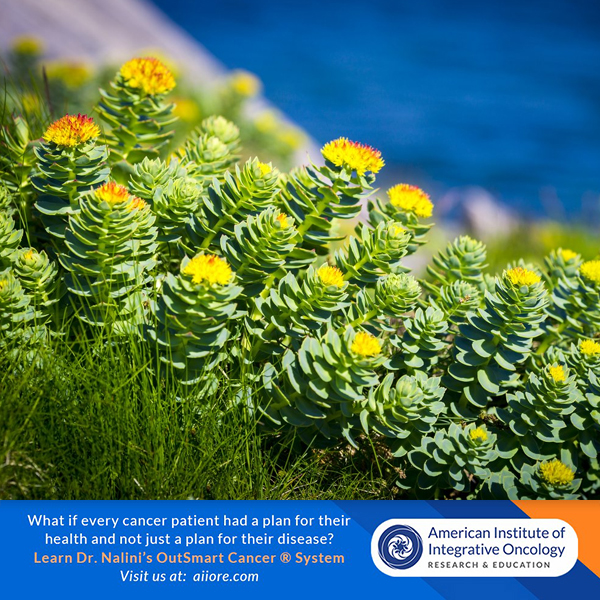Rhodiola (rosea and crenulata spp.) is a botanical adaptogen with broad application in cancer chemoprevention and mitochondrial support for cancer patients undergoing and recovering from cancer therapies.
Rhodiola is considered an adaptogen. It supports multiple functions that enhance resilience, responsiveness and recovery in the face of stress.
 Rhodiola came to widespread prominence when it was used by Olympic athletes, high altitude mountain climbers and long distance runners to enhance endurance and sustained energy over 50 years ago.
Rhodiola came to widespread prominence when it was used by Olympic athletes, high altitude mountain climbers and long distance runners to enhance endurance and sustained energy over 50 years ago.
Rhodiola rosea and its primary active phytochemicals, salidroside and rosavins, have been widely studied for effects on cellular metabolism, energy production, inflammation control, oxidative stress, autophagy and cell death.
Salidroside is known to bind to the cell membrane and enter the cytosol via a membrane transporter where it influences AMPK and improves endothelial function and nitric oxide production, enhances glucose uptake and fatty acid oxidation and inhibit and gluconeogenesis and glycogen synthesis.
AMPK activity is required for cells to respond to stress and changes in energy balance. It is primarily through this pathway that Rhodiola appears to enhance normal mitochondrial function and energy metabolism.
Salidroside is water soluble and highly bioavailable via oral administration and its metabolites are excreted in the urine.
Rhodiola has also been shown to inhibit tumor promoting mTOR pathway and reduce angiogenesis and metastasis by down-regulating expression of HIF1a/HIF2a signaling. Reducint mTOR expression is a goal in chemoprevention and in optimizing the tumor microenvironment.
Rhodiola has demonstrated positive synergistic effects when combined with the chemotherapy agent cyclophosphamide.
Rhodiola metabolites are excreted through the urine and one human study showed that patients with superficial bladder carcinoma who consumed Rhodiola orally reduced the average frequency of recurrence by 50%.
Murine studies have shown that Rhodiola has Immuno-stimulating properties and increases, CD3 and CD4 T cells, Interferon-g and IL-2 cytokines.
Rhodiola demonstrates anti-inflammatory activity by inhibition of COX2, PLA2, NfkB, TNFa, IL-1B and IL-6 which are all upregulated in the tumor microenvironment. Additionally Rhodiola has inhibits expression of the NLRP3 inflammasome which is activated in the lung epithelia both during viral infections as well as malignancy. (As a side note, this property of Rhodiola may also enhance vaccine adjuvant effect and maturation of dendritic cells and promote immune response to vaccine innoculation)
 Rhodiola rosea and Rhodiola crenulata are available as liquid botanical extract and in capsule form. Rhodiola extracts typically contain 3% salidrosides and 1% rosavins. A therapeutic dose of Rhodiola is 3000mg/day.
Rhodiola rosea and Rhodiola crenulata are available as liquid botanical extract and in capsule form. Rhodiola extracts typically contain 3% salidrosides and 1% rosavins. A therapeutic dose of Rhodiola is 3000mg/day.
A maintenance dose for cell protection and healthy aging ranges from 200-1000mg per day. Always use professional grade supplements and suppliers.
Rhodiola has a wide range of applications in chronic syndromes, healthy aging, and chemo-prevention and recovery by positively influencing multiple pathways in the cancer terrain and tumor microenvironment.
Selected References
Rhodiola and salidroside in the treatment
of metabolic disorders
Xiang-Li Bai, et al, DOI : 10.2174/1389557519666190903115424
Rhodiola rosea L.: an herb with anti-stress, anti-aging, and immunostimulating properties for cancer chemoprevention
Yonghong Li , et al DOI: 10.1007/s40495-017-0106-1
mTOR, AMPK, and Sirt1: Key Players in Metabolic Stress Management
Silvia Cetrullo, et al DOI: 10.1615/critreveukaryotgeneexpr.2015012975


